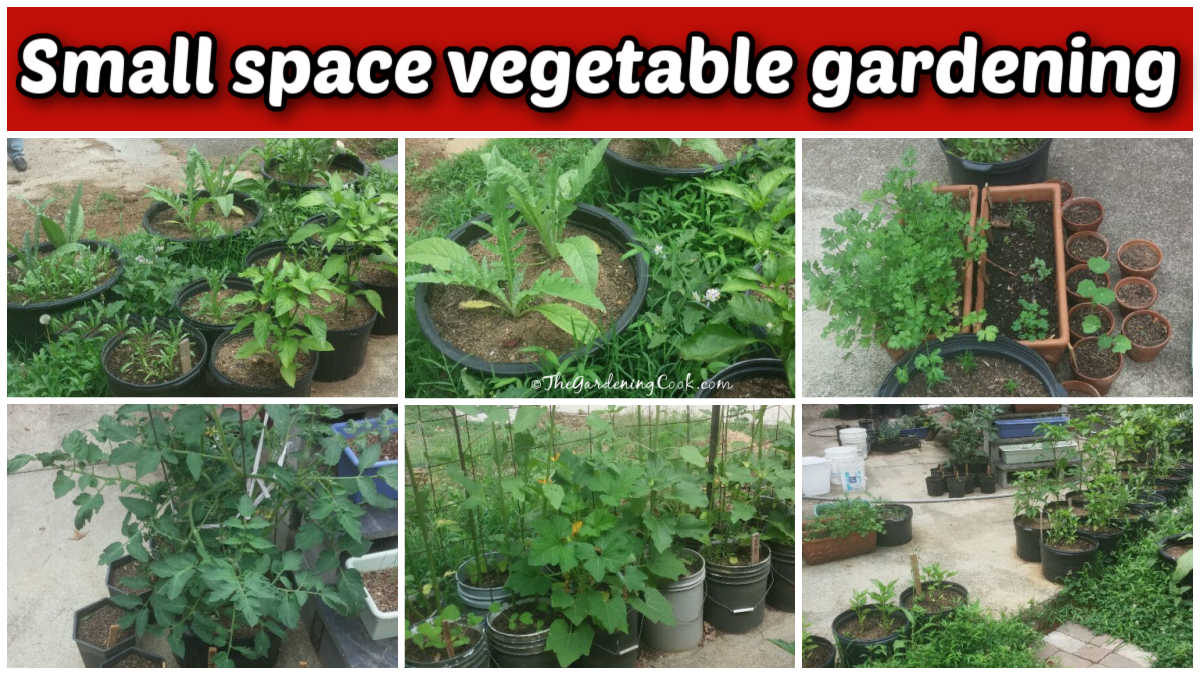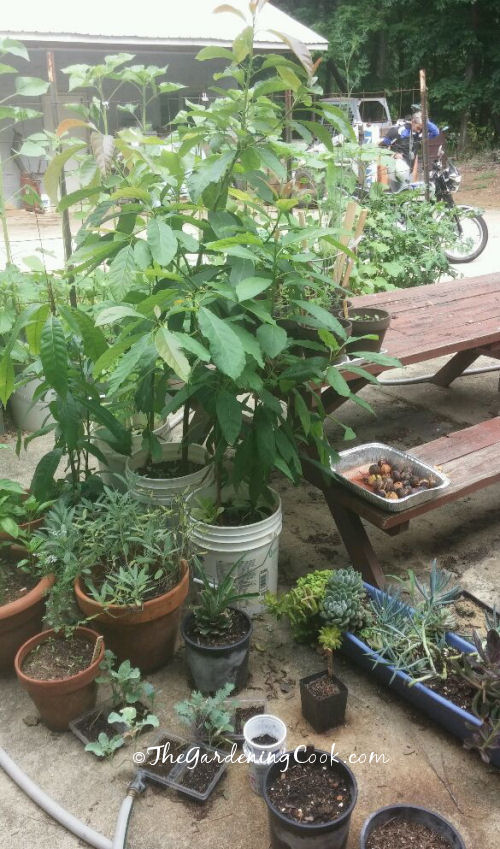A small-space vegetable garden lets you grow fresh produce when you don’t have room for a traditional vegetable garden. With the right setup, patios, balconies, and decks can all be spaces to grow vegetables.
You’ll need containers with good drainage and a quality potting mix. Your area should receive at least 6 hours of sunlight each day.
Many vegetables, including tomatoes, peppers, lettuce, and herbs, grow well in pots and are easy to care for.
Watering and fertilizing are the keys to a productive small-space vegetable garden. With the right care, you’ll be harvesting a steady supply of fresh veggies right outside your door.

Some of the links below are affiliate links. I earn a small commission, at no additional cost to you, if you purchase through an affiliate link.
How to set up a small-space vegetable garden
I recently visited a friend, Meri King, who has a large yard with very little sunlight coming in to it because of the trees on her property. Her main area of sunlight comes directly to her back patio.
She loves to garden and especially loves to grow vegetables. All of her veggies are grown on her patio in containers.
The area of her patio is about 15 x 15 feet. Even in this small space, there is a wide variety of vegetables, flowers, and herbs growing.
Are you in a similar situation? These tips and photos will show you how easy a small-space garden can be.

Containers for vegetable gardening
The containers you choose will affect how well your vegetables grow. Here are some key things to consider.
Size matters
- Small containers dry out quickly and limit root growth. They are best for leafy greens and herbs.
- Large containers retain moisture better. and are stable. They are ideal for vegetables like eggplants, peppers, beans, and tomatoes.
Drainage is essential
- Choose containers with drainage holes on the bottom.
Cost-effective options:
- Containers for vegetable gardens don’t need to be expensive!
- Plastic pails, buckets, or other sturdy containers with holes drilled in the bottom work perfectly.
These five-gallon plastic containers hold several large and healthy tomato plants

Sunlight needs for potted vegetable gardens
Most vegetables require at least 6 hours of direct sunlight daily. Fortunately for my friend, her patio vegetable garden is the one part of her backyard that gets sun for most of the day.
- Place fruiting vegetables such as tomatoes and peppers in the area with the most sun.
- Leafy greens can tolerate partial shade.
- Rotate the containers if the sunlight is uneven.

The best vegetables for small-space gardening
Some vegetables grow better in containers than others do. Choosing the right crops for your small-space garden ensures success.
Good choices for containers are:
- Leafy greens and herbs: lettuce, spinach, chives, oregano, and basil.
- Compact growers: peppers, bush beans, cherry tomatoes, and artichokes.
- Vertical growers: pole beans, cucumbers, peas, and tomatoes. They will need staking or trellises for support.

Soil for small-space vegetable gardens
Avoid garden soil, which can be heavy and compacted. It can also harbor pests and soil-borne diseases.
Instead, choose a good-quality garden soil mix that will drain well but still retain moisture for the vegetables.
Watering and maintenance for vegetables in containers
Containers dry out faster than garden beds do. You will need to check the soil every day.
Water deeply and allow the excess water to drain from the bottom holes in the pots. This will encourage strong roots.
A layer of straw, bark, or shredded leaves will retain moisture and reduce evaporation.
Fertilizing container-grown vegetables
Plants grown in containers rely on added nutrients, since they cannot access those available in garden soil.
- Feed monthly: Vegetables grown in pots need to be fertilized every 2-4 weeks.
- Types of fertilizer to use: Balanced granular or water-soluble mixes give fast results.
- Fertilizer extras: Compost or other organic matter at planting time enriches the soil.
Avoid over-fertilizing. Too much can harm the plants or reduce the flavor of the vegetables.
This area of my friend’s garden contains mainly herbs. Parsley, tarragon, and dill are well-developed.
Meri King also has nasturtiums growing. The nasturtiums are a great companion plant that will attract beneficial insects to the garden to help with pollination.

Supports for tall vegetables
Use trellises, cages, or stakes to support pole beans, cucumbers, and indeterminate tomatoes.
This row of sunflowers will bring pollinators like butterflies and bees to the garden. They are supported by a wire trellis.

Ways to maximize limited space
There are several ways that you can make the most of the space available.
- Planter options: Hanging baskets and wall planters let you grow more vegetables without using floor space.
- Stackable planters: These can also increase your yield.
- Raised garden beds: Raised beds offer more room than pots while still keeping the garden compact.
Vertical gardening improves air circulation, and this reduces the risk of diseases.

Small-space vegetable gardening allows you to grow vegetables even if you don’t have much room in your yard.
Start small with a few containers and expand as you gain experience. Before long, you’ll be harvesting fresh produce that you have grown yourself!
Share this guide to small-space gardening on X
If you enjoyed learning how to grow vegetables in containers, why not share this guide with a friend? Here is a post to get you started:
🌱 No space for a vegetable garden? No problem! Learn how to grow fresh veggies in containers on your patio, balcony, or deck. 🍅🥬 Herbs, tomatoes, and many other vegetables will grow this way! #SmallSpaceGardening #ContainerGardening… Share on XPin these tips for container vegetable gardening
Would you like a reminder of this post for growing vegetables in small spaces? Pin this image to one of your gardening boards on Pinterest so that you can easily find it later.
Admin note: This article for container veggie gardens first appeared on the blog in July 2014. This post has been updated with all new photos, more tips and a slideshow video.